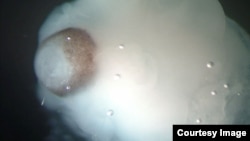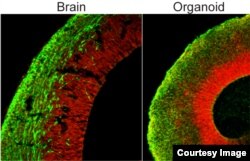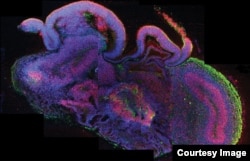They’re the closest thing to human brains that scientists have grown in the lab.
Researchers in Austria and the United Kingdom have nurtured human cells into pea-sized clusters of tissues with striking similarities to embryonic brains.
They provide an unprecedented opportunity to study how disorders such as schizophrenia and autism develop.
The researchers began with stem cells, which can become any type of tissue in the body.
With a little chemical coaxing and a protein scaffold to grow on, they followed the same developmental steps that human brains do. They formed distinct regions resembling those found at about nine weeks after conception. Some even had the beginnings of a retina.
Not quite brains
“All of these steps we have in our cultures, to a level of precision that is totally unexpected," said Juergen Knoblich at the Austrian Academy of Science, who directed the research.
"But if you zoom out and look at the whole, the whole is just not a brain,” he said.
Instead, writing in Nature, he and his colleagues call them “cerebral organoids” - not quite brains, but similar.
Scrambled cerebrum
Knoblich says these brain-like blobs can’t replace what’s between your ears.
For one thing, although many of the parts are there, they’re not in the right places. He says it’s like a car gone wrong.
“You have an engine, you have the wheels. But the engine would be on the roof and the gearbox would be attached to that. But you can still take that car and analyze how an engine works,” Knoblich said.
What these cerebral organoids excel at, he says, is offering a picture of how the brain develops, and how that development can go wrong.
Dysfunctional development
One example is a condition called microcephaly. Patients with the disorder develop very small brains and are severely mentally disabled.
Knoblich’s colleagues took skin cells from a microcephaly patient and reprogrammed them into stem cells.
Lead author Madeline Lancaster grew them in the lab, and immediately noticed that "the overall size of the patient-dervied organoids was much smaller.”
When Lancaster examined how the cells inside the organoids were developing, she found they were different from normal brains in an important way.
This early in life, stem cells are usually multiplying and making more stem cells. But in the microcephaly patients, Lancaster found the stem cells had already started differentiating into the cells that carry signals in the brain, called neurons.
“The stem cells were not expanding like they should and they were making neurons too early," she said. "And we think that this depletion of these stem cells leads to the overall size decrease because in the end, less neurons can be made.”
Other uses
These test tube brains could also be put to use studying more common disorders like schizophrenia and autism.
Although those conditions don’t typically show up until later in life, "it has been shown that the underlying defects already occurred during the development of the brain," Knoblich said. "And we are confident and hope that we might be able to model some of these defects in our organoids as well.”
Knoblich is not sure scientists will ever be able to recreate the complexity of the human brain in a test tube.
Researchers in Austria and the United Kingdom have nurtured human cells into pea-sized clusters of tissues with striking similarities to embryonic brains.
They provide an unprecedented opportunity to study how disorders such as schizophrenia and autism develop.
The researchers began with stem cells, which can become any type of tissue in the body.
With a little chemical coaxing and a protein scaffold to grow on, they followed the same developmental steps that human brains do. They formed distinct regions resembling those found at about nine weeks after conception. Some even had the beginnings of a retina.
Not quite brains
“All of these steps we have in our cultures, to a level of precision that is totally unexpected," said Juergen Knoblich at the Austrian Academy of Science, who directed the research.
"But if you zoom out and look at the whole, the whole is just not a brain,” he said.
Instead, writing in Nature, he and his colleagues call them “cerebral organoids” - not quite brains, but similar.
Scrambled cerebrum
Knoblich says these brain-like blobs can’t replace what’s between your ears.
For one thing, although many of the parts are there, they’re not in the right places. He says it’s like a car gone wrong.
“You have an engine, you have the wheels. But the engine would be on the roof and the gearbox would be attached to that. But you can still take that car and analyze how an engine works,” Knoblich said.
What these cerebral organoids excel at, he says, is offering a picture of how the brain develops, and how that development can go wrong.
Dysfunctional development
One example is a condition called microcephaly. Patients with the disorder develop very small brains and are severely mentally disabled.
Knoblich’s colleagues took skin cells from a microcephaly patient and reprogrammed them into stem cells.
Lead author Madeline Lancaster grew them in the lab, and immediately noticed that "the overall size of the patient-dervied organoids was much smaller.”
When Lancaster examined how the cells inside the organoids were developing, she found they were different from normal brains in an important way.
This early in life, stem cells are usually multiplying and making more stem cells. But in the microcephaly patients, Lancaster found the stem cells had already started differentiating into the cells that carry signals in the brain, called neurons.
“The stem cells were not expanding like they should and they were making neurons too early," she said. "And we think that this depletion of these stem cells leads to the overall size decrease because in the end, less neurons can be made.”
Other uses
These test tube brains could also be put to use studying more common disorders like schizophrenia and autism.
Although those conditions don’t typically show up until later in life, "it has been shown that the underlying defects already occurred during the development of the brain," Knoblich said. "And we are confident and hope that we might be able to model some of these defects in our organoids as well.”
Knoblich is not sure scientists will ever be able to recreate the complexity of the human brain in a test tube.
“Besides the fact that I think we would run into very severe ethical problems," he said. "I do not think this will be possible.”
So keep your head on your shoulders. Scientists aren’t likely to replace it anytime soon.
So keep your head on your shoulders. Scientists aren’t likely to replace it anytime soon.












